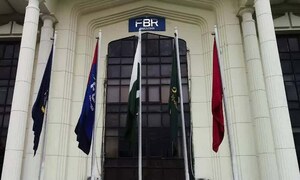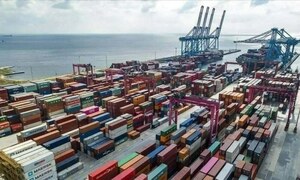Pakistan is now definitely going to the IMF. The meeting recently of the Finance Minister with the IMF Managing Director in Bali confirms that a formal request has been placed for an IMF program. A staff Mission of the Fund will be coming to Pakistan on the 7th of November. Sooner would have been better.
The frequency historically of Pakistan going to the IMF is relatively high. Since 2008 there has been first a Standby facility negotiated by the PPP government which was not completed. This was followed in 2013 by the Extended Fund Facility finalized with the IMF by the PML (N) government. This program is unique in that was successfully completed but did not lead to sustainable growth. Now we have the Tehreek-e-Insaf government starting the process of arranging a program with the IMF. This ought to have started somewhat earlier. Given the size of the financing gap seeking support from friendly countries and going to the IMF are not mutually exclusive options. They supplement each other.
Therefore, in effect Pakistan will see the commencement and operation of three Fund Programmes in the last decade. This predilection of Pakistan towards the IMF raises a number of important questions: Is this the reflection of deep-rooted structural problems which come to the surface every few years or is it due to exogenous external shocks? Is there a, more or less, acute need for an IMF programme this time compared to the last two times? The answer in particular to the last question will help in assessing the quantum of support required and the likely toughness of the conditionalities, including the prior actions.
The 10 programmes from 1988 to 2008 were largely the reflection of internal factors with the exception of the programmes in 2000 and 2008. The former Program became essential as Pakistan tried to re-enter on a normal basis the world economy following the sanctions imposed after the bomb blasts. This return to the IMF was subsequently facilitated by Pakistan's support to the US in the Afghan war. The program in 2008 was clearly the consequence of an unprecedented price hike of oil to $152 per barrel.
The root causes of the incipient financial crisis today and the need ultimately to go to the IMF are a unique combination of both internal and external factors. Due to a wrong set of policies, especially with regard to the exchange rate, Pakistan has been afflicted by a very rare form of the 'Dutch Disease'. Large external borrowings have been used since 2014 to keep the exchange rate nominally stable while leading to a plummeting of exports and mushrooming of imports, thereby causing a big widening of the trade gap and resulting in a much larger current account deficit. The excessive external borrowing has also led simultaneously to a fast rise in debt repayment liabilities. Combined together the external financing needs reached a peak of $24 billion in 2017-18 which could only be financed by a big drawdown of reserves of $6.4 billion, beyond the normal sources of borrowing and FDI.
The second factor currently is a growing external shock. The oil price has started rising since mid-2016 after being exceptionally low for over two years. Now it has approached almost $82 per barrel as compared to the average of $62 per barrel last year. Every additional $10 per barrel now adds almost $1.5 billion to the import bill of Pakistan. Some forecasts are that oil could even touch $100 per barrel, following the second set of US sanctions that will kick in next month.
A revealing measure of the extent of pressure to seek balance of payments support from the IMF is the ratio of level of foreign exchange reserves of the SBP with the external finance requirements at the time of going to the Fund. The latter consists of the current account deficit plus the due external debt repayment.
In 2008, the external finance requirement was $17.5 billion, with reserves of $8.5 billion, implying thereby a ratio of just over two. The position was better in 2013 when the ratio was below 1.5. Now it is above three and approaching four. Clearly, the pressure for going to the IMF is much greater this time with the annual external financing requirement currently of over $30 billion and reserves of just over $8 billion.
What then is the type and size of the Program that the Authorities may seek from the IMF? The normal access is close to $6 billion, since Pakistan has already borrowed $6.4 billion in the last Program. Clearly, given the large net financing gap in 2018-19 of $12 to $14 billion, the Fund will have to agree to a Program size much above $6 billion. Also, Pakistan needs at least two years to undertake and implement wide-ranging reforms to stabilize the economy and lay the basis for higher and more sustainable growth. Therefore, if the Program is sufficiently large of up to $12 billion over a period of three years then the choice should be for an Extended Fund Facility. This is preferable to a Standby facility also because the repayment is stretched over a much longer period than in the latter case.
A programme size of about $12 billion will mean that Pakistan will be accessing in total about 600 percent of its quota. This is not unusual. Countries like Greece and Argentina have been able to get programmes from the IMF with funding almost 10 times their quota. The programme size of about $12 billion over three years will also give some 'breathing space' to design and implement the necessary structural reforms. Initially; however, the emphasis will inevitably have to be on adopting strong contractionary fiscal and monetary policies.
What will be the size of the adjustment required by Pakistan? The likelihood is that the target for the current account deficit in 2018-19 will be around $12 billion as compared to $18 billion last year. In effect, the net financing gap could be closed with one half by a strong adjustment and one half with injection of funds by the IMF as part of the Programme.
There is no doubt that there will be high costs of the adjustment process. By the end of the current financial year inflation may reach a double digit rate of 13 percent to 15 percent. Along with the poor outcome expected currently from major crops, the GDP growth rate could fall to between 3.5 to 4 percent in 2018-19. Special efforts will have to be made to reduce the negative impact on employment and poverty.
Unfortunately, Pakistan today is in quagmire. This is the consequence of the legacy of a highly unsustainable economy left behind by the previous Government. Not going to the IMF would have enhanced greatly the probability of coming close to a default in international transactions leading to shortages in essential imports, substantially higher inflation and a much weaker currency.
We hope that the IMF will behave like the true lender of last resort globally and that the negotiations will not be complicated by extraneous factors. Before the Fund mission arrives, the Ministry and the SBP, along with other line Ministries, ought to complete the process of preparing home grown reforms for presentation during the negotiations. Hopefully, this will keep the initiative in Pakistan's hands.
(The writer is Professor Emeritus at BNU and former Federal Minister)
BR100
11,839
Decreased By
-27.2 (-0.23%)
BR30
35,827
Increased By
129.6 (0.36%)
KSE100
113,563
Decreased By
-585.5 (-0.51%)
KSE30
35,742
Decreased By
-210.4 (-0.59%)

























Comments
Comments are closed.